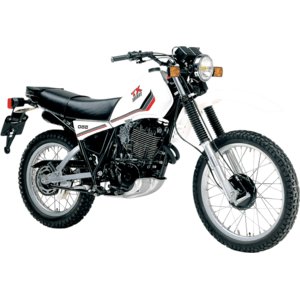Yamaha XT 550 (1982-1983): The Thumper That Defined Toughness
Introduction
The Yamaha XT 550, produced from 1982 to 1983, is a motorcycle that refuses to fade into obscurity. As a dual-sport machine built during the golden era of "do-it-all" bikes, it straddles the line between rugged off-road capability and street-friendly practicality. Riding this air-cooled thumper feels like shaking hands with history—a time when motorcycles were less about digital dashboards and more about raw, mechanical connection. Let’s dive into what makes this single-cylinder legend a favorite among vintage enthusiasts and modern-day adventurers alike.
Design & Build Quality
The XT 550’s design screams purpose. Its high-mounted fenders, slim fuel tank, and upright riding position reflect its dual-sport DNA. The 558cc single-cylinder engine dominates the frame, painted in Yamaha’s classic white-and-red livery that still turns heads today. While the plastics are minimal, the metal components—from the steel exhaust to the rugged spoke wheels—feel built to survive apocalypses.
The air-cooled engine is a masterpiece of simplicity. With no radiators or coolant hoses to worry about, the design stays clean and lightweight (dry weight clocks in at approximately 145 kg / 320 lbs). The 12-liter fuel tank (3.17 gallons) might seem small by modern standards, but it’s sufficient for a 200-250 km (124-155 mi) range, perfect for backcountry exploration.
On-Road Performance
Fire up the engine, and the XT 550 announces itself with a deep, throaty exhaust note. The 38 PS (28 kW) power figure might not sound impressive, but the 49 Nm (36 lb-ft) of torque ensures lively acceleration. On paved roads, the bike feels surprisingly nimble. The 15/39 sprocket ratio provides enough pep for city traffic, though highway cruising at 100 km/h (62 mph) demands patience. Vibrations are ever-present—a hallmark of big singles—but they add character rather than annoyance.
The suspension setup (369 mL of SAE 10W oil per fork leg) soaks up bumps competently, though it’s tuned more for dirt than tarmac. Braking is via a single disc upfront and a drum rear—adequate for its era but requiring deliberate input by today’s standards.
Off-Road Capabilities
This is where the XT 550 truly shines. The 21-inch front and 18-inch rear wheels (with 1.5 BAR / 21.7 PSI tire pressure) float over gravel and dig into mud with equal confidence. The long-travel suspension handles jumps and ruts gracefully, though hardcore riders might want stiffer springs for aggressive trails.
The engine’s torque curve is a gift off-road. Low-end grunt lets you chug up steep inclines without feathering the clutch, while the 5-speed transmission’s wide ratios keep you in the powerband. At 850 mm (33.5 inches) seat height, it’s accessible for average riders, though the narrow seat ensures you’ll feel every rock after an hour in the saddle.
Competition
In the early ’80s dual-sport arena, the XT 550 faced stiff rivals:
- Honda XL500S: Lighter (135 kg / 298 lbs) but less powerful (27 PS), the XL500S prioritized agility over brute force. Its rear drum brake and weaker low-end torque made it less versatile for heavy off-roading.
- Suzuki DR500: Similar in specs, the DR500 matched the XT’s torque but suffered from vibration issues. Its shorter gearing excelled in tight trails but limited highway comfort.
- Kawasaki KLR600: Arriving later (1984), the KLR600 offered liquid cooling and a larger tank but added weight. The XT’s simplicity gave it an edge for DIY mechanics.
The XT 550 carved its niche with a balanced mix of power, durability, and ease of maintenance—a trifecta that still resonates with riders today.
Maintenance
Owning an XT 550 is a lesson in straightforward mechanics. Here’s what to prioritize:
-
Valve Adjustments
Valve clearances (intake: 0.05–0.10 mm / 0.002–0.004 in; exhaust: 0.12–0.17 mm / 0.005–0.007 in) should be checked every 3,000 km (1,864 mi). Use MOTOPARTS.store’s precision feeler gauges for accurate measurements. -
Oil Changes
Yamaha recommends SAE 20W-40 oil (1.9L with filter). Modern synthetics like MOTOPARTS.store’s 20W-50 Premium Oil improve heat resistance during long rides. -
Chain Care
The 97-link chain and 15/39 sprockets demand regular lubrication. Our X-Ring Chain Kit reduces wear and stretches service intervals. -
Carburetor Tuning
The stock Mikuni carb runs lean by today’s ethanol-blend standards. MOTOPARTS.store’s jetting kits optimize airflow and fuel mixture for smoother throttle response. -
Suspension Refresh
Replace fork oil (SAE 10W) every two years. For off-roaders, our Heavy-Duty Fork Springs add stability without sacrificing plushness.
Final Thoughts
The Yamaha XT 550 isn’t just a motorcycle—it’s a passport to adventure. Its imperfections (vibrations, basic suspension) become virtues when you’re carving trails or navigating urban jungles. While modern dual-sports offer more refinement, few match the XT’s raw authenticity. Whether you’re restoring a barn find or upgrading a daily rider, MOTOPARTS.store has the parts to keep your XT 550 alive for another 40 years. After all, legends don’t retire; they just need a little love.



















